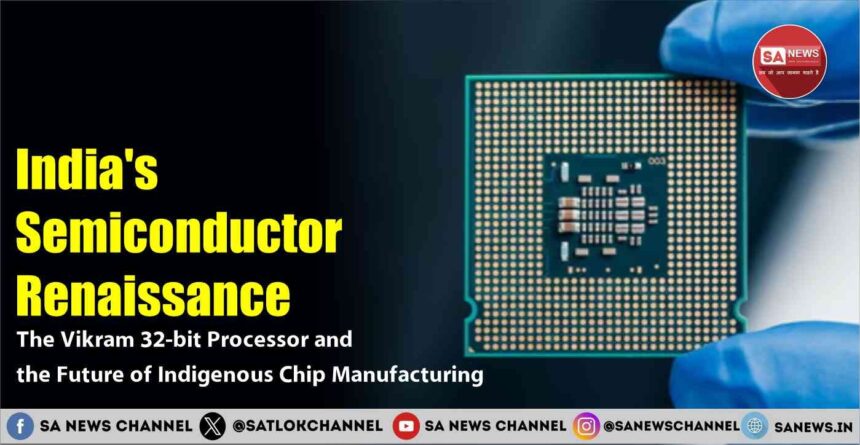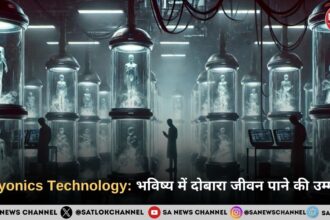On September 2, 2025, a defining moment in India’s technological narrative unfolded. Union IT Minister Ashwini Vaishnaw presented the VIKRAM3201, the nation’s first fully indigenous 32-bit space-grade microprocessor.
- The Vikram 32-bit Processor: Technical Marvel and Strategic Asset
- Evolution of India’s Semiconductor Journey: From Promise to Setback to Revival
- The Early Promise (1980s)
- The Devastating Setback (1989)
- The Lost Decades
- The Dawn of a New Era: The India Semiconductor Mission
- A Catalyst for Transformation: Indian Semiconductor Mission
- India’s Competitive Edge
- Conclusion: A New Chapter in India’s Technological Journey
- The Bigger Picture: Spiritual Revelation
- FAQs on India’s Semiconductor Renaissance: The Vikram 32-bit Processor
- 1. What makes the VIKRAM3201 special compared to regular chips?
- 2. Why did India use 180nm technology instead of the latest cutting-edge process?
- 3. How long has India been chasing the semiconductor dream?
- 4. What is the India Semiconductor Mission all about?
- 5. Why does this single chip matter so much?
- Connect With Us on the Following Social Media Platforms
This single chip, a marvel of engineering, represents far more than a technological breakthrough; it symbolizes the culmination of a four-decade-long odyssey, a story of soaring ambition, devastating setbacks, and an unyielding resolve to achieve self-reliance in the world’s most critical technology.
In this article, we’ll walk through with chronicles of India’s semiconductor renaissance, from the pioneering VIKRAM32 processor to the ambitious national mission that aims to position India as a formidable force in the global chip manufacturing landscape so read on!
The Vikram 32-bit Processor: Technical Marvel and Strategic Asset
Developed jointly by the Indian Space Research Organisation’s (ISRO) Vikram Sarabhai Space Centre and the Semiconductor Laboratory (SCL) in Chandigarh, the VIKRAM3201 is a testament to India’s growing prowess in sophisticated electronics. It marks a generational leap from its 16-bit predecessor, which has been the reliable workhorse of ISRO’s launch vehicles since 2009.

Advanced Architecture and Unmatched Resilience
The processor is built on a 32-bit architecture featuring 152 instructions and thirty-two 32-bit registers. Operating at a brisk 100 MHz while consuming less than 500 mW of power, it demonstrates remarkable efficiency, a critical parameter for space applications.
What truly distinguishes the VIKRAM3201 is its extraordinary resilience. Designed to be radiation-hardened, it can operate flawlessly in the most extreme environmental conditions imaginable, withstanding temperatures ranging from a frigid -55°C to a scorching +125°C. This robustness makes it ideally suited for the harsh realities of space missions, where it must endure intense vibrations during launch and constant exposure to cosmic radiation.
A True “Make-in-India” Marvel
The processor’s significance is magnified by its completely indigenous development ecosystem. Every associated software tool, compilers, assemblers, linkers, and the integrated development environment was developed in-house by ISRO. This comprehensive approach eliminates dependence on foreign software and ensures complete technological sovereignty, a crucial advantage in the strategic space and defense sectors.
The VIKRAM3201 was born in the quiet corridors of SCL’s 180nm CMOS facility in Punjab, a product not just of silicon and circuitry, but of India’s determination to stand tall in the world of technology. At first glance, the 180nm process might seem modest compared to the cutting-edge chips that power modern smartphones. But in the unforgiving environment of space, reliability outweighs raw speed, and this time-tested technology becomes a virtue rather than a compromise.
That virtue was put to the test aboard the PSLV-C60 mission, where the chip took command of the Mission Management Computer. With the successful validation of VIKRAM3201 in orbit, India didn’t just prove the chip’s readiness for ISRO’s future missions, it proved that homegrown ingenuity can carry the nation’s dreams beyond the atmosphere.
Evolution of India’s Semiconductor Journey: From Promise to Setback to Revival
The VIKRAM3201 processor, developed jointly by ISRO’s Vikram Sarabhai Space Centre and the Semiconductor Laboratory (SCL) in Chandigarh, marks a generational leap from its 16-bit predecessor and signals India’s emergence as a credible player in the global semiconductor ecosystem.
As Prime Minister Modi stated during the event, while “oil was black gold,” semiconductors are the “digital diamonds” of the 21st century.

Now, to truly value what the VIKRAM32 has achieved, we first need to look at the rocky journey of India’s chip-making dreams.
The Early Promise (1980s)
India’s journey began with incredible promise. In 1984, three years before the founding of Taiwan’s world-dominating TSMC, India established the Semiconductor Complex Limited (SCL) in Chandigarh. Partnering with American Microsystems Inc., the facility began operations with 5-micron technology, positioning India among the early adopters of chip manufacturing.
Also Read: Fusion Energy: The Key to Decarbonization?
By 1988, SCL had upgraded to 0.8-micron processes, placing it merely two years behind the global cutting edge. With engineers trained abroad, the facility was successfully producing chips for telecommunications, electronics, and defense, even exporting its products across Asia and Europe. India was on the cusp of becoming a semiconductor leader.
The Devastating Setback (1989)
Then, disaster struck. In 1989, a catastrophic fire ravaged SCL’s infrastructure, turning the nation’s silicon dream to ash. The incident, which some still suspect involved sabotage, brought India’s progress to a grinding halt for nearly two decades. The timing could not have been worse. As India struggled to recover, nations like Taiwan, South Korea, and Singapore seized the moment, investing heavily to build the industrial empires that dominate the semiconductor world today.
The Lost Decades
The economic liberalization of the 1990s, while transformative for India’s IT services industry, paradoxically hindered its manufacturing ambitions. The influx of cheap semiconductor imports made domestic production economically unviable. Inadequate government support and a restrictive regulatory environment saw India miss several critical opportunities, including potential partnerships with giants like Texas Instruments, who chose other Asian nations for their manufacturing bases. While companies like Infosys and Wipro became global software titans, India grew increasingly dependent on imports for the hardware that powered its digital revolution.
The Dawn of a New Era: The India Semiconductor Mission
Around 2020, the tide began to turn. The COVID-19 pandemic exposed the fragility of global supply chains, and escalating geopolitical tensions underscored the strategic necessity of semiconductor self-reliance. This realization sparked a modern renaissance in India’s policy circles. Just like that, India Semiconductor Mission started in full throttle.
A Catalyst for Transformation: Indian Semiconductor Mission
The most decisive step in this revival was the establishment of the India Semiconductor Mission (ISM) in December 2021. With a massive initial outlay of ₹76,000 crore ($10 billion), it represents the most ambitious and comprehensive semiconductor development program in the nation’s history. Under the Ministry of Electronics and Information Technology (MeitY), ISM is tasked with creating a vibrant and sustainable semiconductor and display ecosystem in India.

Building a Nationwide Ecosystem
The mission’s impact has been swift and substantial. Ten major projects have already been approved across six states, with a total investment commitment reaching a staggering ₹1.60 lakh crore ($19 billion). These projects demonstrate a holistic strategy to build capabilities across the entire value chain:
- Tata Electronics-PSMC Partnership: The flagship project is a ₹91,000 crore semiconductor fabrication facility in Dholera, Gujarat. A partnership with Taiwan’s Powerchip Semiconductor Manufacturing Corp (PSMC), this fab will produce 50,000 wafers per month starting in 2026, focusing on the 28nm technology node crucial for the automotive, mobile, and AI sectors.
- Micron Technology Assembly Facility: In Sanand, Gujarat, American memory giant Micron is establishing a ₹22,900 crore Assembly, Testing, Marking, and Packaging (ATMP) facility. Expected to become operational by late 2025, this plant represents a critical step in the semiconductor value chain.
- CG Power OSAT Facility: This ₹7,600 crore Outsourced Semiconductor Assembly and Test (OSAT) facility, a joint venture between CG Power, Renesas Electronics (Japan), and Stars Microelectronics (Thailand), is already in pilot production and will handle millions of units per day when fully operational.
Beyond traditional silicon, India is also venturing into advanced compound semiconductors. Recent approvals include the nation’s first commercial Silicon Carbide (SiC) fabrication plant, critical for high-voltage, high-temperature applications in defense systems, electric vehicles, and space exploration.
India’s Competitive Edge
India is entering a fiercely competitive global market dominated by established players. Taiwan, through TSMC, controls nearly 60% of global production. South Korea excels in memory chips, while the United States leads in innovation and chip design.
Despite its late entry into high-volume manufacturing, India possesses significant competitive advantages. The country is home to nearly 20% of the world’s semiconductor design engineers, a formidable talent pool that has long contributed to the success of global chip companies. This profound strength in design provides a solid foundation upon which to build manufacturing capabilities. Furthermore, India’s large and rapidly growing domestic market for electronics provides a powerful incentive for local production.
Also Read: SEMICON India 2025: Shaping India’s Semiconductor Powerhouse
The path ahead is not without its challenges. Building a self-reliant ecosystem from the ground up requires overcoming several critical hurdles:
Supply Chain Dependencies
High-volume chipmaking relies on a steady stream of high-purity silicon wafers, specialty gases, and chemicals. India’s chemical sector is strong, but producing materials that meet semiconductor-grade standards requires further scaling and specialization. Without this, fabs will remain dependent on imports for critical inputs.
Talent Gap in Manufacturing
While strong in design, India faces a shortage of specialized talent in the nuanced fields of semiconductor fabrication and process engineering. The country will need an estimated 1.5 million skilled workers for this industry by 2027.
Infrastructure Demands
Building a modern chip factory is expensive and requires the perfect conditions to run and that means billions of dollars, power that never flickers, and water so pure it makes bottled water look dirty.
Conclusion: A New Chapter in India’s Technological Journey
The story of the VIKRAM3201 is not just about silicon, circuits, or even space, it’s about resilience. Four decades ago, India dreamt of standing shoulder-to-shoulder with the world in semiconductor technology. That dream was almost lost in the smoke of the 1989 fire, buried under years of missed chances and global races that left us behind.
And yet, here we are. In 2025, a homegrown chip rode into space and guided a rocket with steady precision. It’s proof that even delayed dreams can take flight when carried by grit and vision.
The challenges ahead are real given the factories that demand perfection, supply chains that run deeper than oceans, and the need for countless skilled hands to bring it all together. But for the first time in decades, the direction feels right.
India is no longer just a participant in the digital age; it is beginning to script its own chapter. And the VIKRAM3201 may well be remembered as the spark that lit the country’s semiconductor renaissance.
The Bigger Picture: Spiritual Revelation
While India leaps ahead with scientific and technological innovations to become a Vishwaguru, Jagatguru Sant Rampal Ji has been making constant efforts to aid this mission by bringing about societal reform, uniting humanity with the thread of spirituality, promoting moral and ethical values, and uplifting those in need.
Throughout the evolution of mankind, We’ve come across several instances where we are left in awe, seeking answers about the existence of God.While some completely brushed it off, the others made up a philosophically good-sounding answer to it.
However, deep down our souls continue to have that lingering feeling of the search for the true Supreme Being, who is responsible for the creation of this universe and taking care of us
The words of the Real Saint are divine. Saint Rampal Ji Maharaj is the only True Guru, who delivers spiritual discourses by providing evidence from our Holy books & scriptures and has proved that Lord Kabir is the Supreme Almighty God, testifying this fact from the Holy books of all religions.
“Whenever there is an increase in unrighteousness and distortion in the path of devotion; At that time, the Almighty God Himself descends on earth to establish righteousness by imparting true spiritual knowledge based on holy scriptures”.
FAQs on India’s Semiconductor Renaissance: The Vikram 32-bit Processor
1. What makes the VIKRAM3201 special compared to regular chips?
Unlike the chips in your phone, the VIKRAM3201 is built to survive space—radiation, extreme heat, freezing cold, and the rough shake of a rocket launch.
2. Why did India use 180nm technology instead of the latest cutting-edge process?
Because in space, reliability matters more than speed. Older, proven tech like 180nm is sturdy, predictable, and less likely to fail when it counts.
3. How long has India been chasing the semiconductor dream?
Since the 1980s! We were once close to the global frontlines, but a devastating fire in 1989 set us back decades. The VIKRAM3201 is a comeback story.
4. What is the India Semiconductor Mission all about?
It’s a national drive launched in 2021 to build fabs, train talent, and make India less dependent on foreign chips, backed by $10 billion in government support.
5. Why does this single chip matter so much?
Because it’s not just silicon, it’s a symbol. The VIKRAM3201 proves India can design, build, and test world-class chips at home, paving the way for a self-reliant future.









